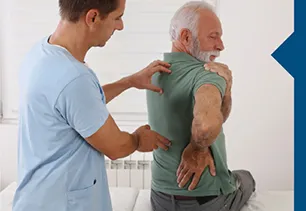Degenerative disc disease (DDD) is a common condition that affects the intervertebral discs in the spine. Despite its name, degenerative disc disease doesn’t result in chronic pain for everyone who has it. This misconception has led to a broad misunderstanding of the condition and its relationship to pain. In this blog, we’ll delve into the truth behind degenerative disc disease and how physical therapy plays a crucial role in managing the condition.
Understanding Degenerative Disc Disease
Degenerative disc disease is a natural part of the aging process. Over time, the intervertebral discs, which act as shock absorbers between the vertebrae, can gradually lose their ability to provide cushioning and support. This degeneration can lead to changes in the structure and function of the spine. Contrary to popular belief, degenerative disc disease is not an inherently painful condition. Many people with DDD never experience any pain or discomfort.
Lack of Correlation Between DDD Severity and Pain:
Several studies have indicated that there isn’t always a direct correlation between the severity of degenerative disc disease as seen on X-rays and the presence or intensity of pain. Some individuals with significant disc degeneration may not experience pain, while others with relatively mild degeneration might suffer from chronic pain. This suggests that factors beyond structural changes, such as inflammation, nerve compression, and individual pain perception, play a significant role in determining pain levels.
The Role of Physical Therapy
Physical therapy is a key component in managing degenerative disc disease, especially for individuals who do experience pain. The main goal of physical therapy is to improve the strength, flexibility, and stability of the spine, surrounding muscles, and connective tissues. By doing so, physical therapy can help alleviate pain, improve function, and enhance overall quality of life.
Benefits of Physical Therapy for Degenerative Disc Disease:
- Pain Relief: Physical therapists use various techniques such as manual therapy, stretching, and exercise to address pain and discomfort associated with DDD.
- Improved Posture: Correcting poor posture can reduce stress on the spine and alleviate pain. Physical therapists can educate patients about proper posture and provide exercises to reinforce these corrections.
- Muscle Conditioning: Strengthening the muscles that support the spine can enhance stability and reduce the strain on degenerated discs.
- Flexibility Enhancement: Gentle stretching exercises can help maintain or improve the flexibility of the spine and surrounding musculature, preventing further limitations in movement.
- Lifestyle Guidance: Physical therapists educate patients on ergonomics, body mechanics, and activities to avoid, minimizing the risk of exacerbating pain.
It’s important to note that the correlation between X-ray findings and pain is weak. Clinical assessment by healthcare professionals, including physical examination and patient history, remains crucial in determining the cause of pain. Imaging, such as X-rays and MRIs, provides information, but a comprehensive approach that considers both clinical and imaging findings is essential for accurate diagnosis and effective treatment.
Degenerative disc disease is not a condition that universally results in pain. Some people live with DDD without experiencing discomfort, while others might find it to be a significant source of pain. Understanding that pain is a complex interplay of factors and that physical therapy can be a powerful tool in managing the condition is crucial. If you’re dealing with degenerative disc disease, consulting a medical professional and considering physical therapy could be your pathway to a better quality of life.

